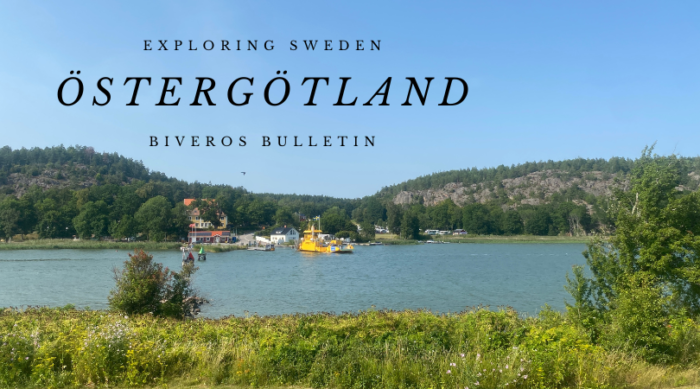Åtvidaberg, or Åtvid, is a town in the province of Östergötland in eastern Sweden. It was once home to the company Facit AB but is today finding other ways to occupy its around 6.900 inhabitants. The town developed from a former mining community to an advanced industrial center with a love for football.





Our Impression of Åtvidaberg
Visiting Åtvidaberg is a bit different. It is hard to find a center from where it is possible to see the town and its sights. Yes, there is a small commercial center in the middle of Åtvidaberg, but this is not close to any other sight than the town hall. It is still possible to explore on foot, but it will take a bit more time than first expected. We are, however, able to tell you one thing. Åtvidaberg might be a town with an industrial past, but you will not find the stereotypical grey Swedish town here if you visit during a sunny summer day.





A Short History of Åtvidaberg
The area around Åtvidaberg was for centuries known for its rich mineral deposits, such as copper. The documented mines date back to the year 1413 and mining continued for about a century thereafter.
It was the second rush for cupper that would create what we know as Åtvidaberg. This was originally a village known as Åtvid, which was the seat of the local parish. The parish had its origins in the Middle Ages and what is today the town’s old church was probably first built during the first mining era. The second mining era began in 1754 when David Hallonqvist received the rights to mining in the area. This second mining era lasted for a century until the 1850s when the copper deposits were depleted.
The mining had, however, only been the start of the industrialization of Åtvid. When the mine was closed it was replaced by a company that would be at the center of Åtvidaberg’s development – later known as Facit AB. The company started as the first European manufacturer of office furniture under the ownership of the former mine owner Theodor Adelswärd. The company was founded in 1906 and was originally known as AB Åtvidabergs Industrier. It went bankrupt in 1922 but was reconstructed already the same year. Facit AB became famous for its mechanical calculators. After decades of different owners and minor failures, the last part of the company was terminated in 1998.





Things to Do and See
Åtvidaberg mixes historical sights with modern industry and you are never far from the surrounding countryside. The many sights might be spread out, but they are reachable on foot from most parts of the town center.
ÅSSA Industri- och Bilmuseum
The ÅSSA Industri- och Bilmuseum is an industry and car museum focused on the company ÅSSA. ÅSSA was founded in 1907 and manufactured the early version of cars. Their production later evolved into manufacturing components for cars and aircraft.
Åtvidabergs Bruks- och Facitmuseum
The Åtvidabergs Bruks- och Facitmuseum is the museum that covers the local history and the town’s former main employer Facit AB. This is where you can learn how the village developed around mining and large industrial manufacturing.
Åtvids Nya Kyrka
Åtvid’s New Church was built in the 1880s and inaugurated in 1885. It replaced the former parish church that was later demolished. The church is a part of Åtvid Congregation within the Evangelical Lutheran Church of Sweden.
Åtvids Gamla Kyrka
Åtvid’s Old Church has its origins in the Middle Ages, but the current church is much newer. The original church is believed to have existed here during the 14th century. That church was, however, demolished in 1887 after the construction of the new church mentioned above. It would take until the 1950s before the old church was revived based on construction plans from the 18th century. It was once more inaugurated in 1957.
Åtvidabergs Kanal
Between Lake Bysjön and the local power plant a canal was built in 1905. The purpose of the canal was to supply the power plant with water and it still goes through the parts of Åtvidaberg today.
Folkparken
Folkparken is a park close to the center of Åtvidaberg that was established in 1908. The park includes a playground as well as a scene. The scene is used to house local events.
Solkanonen
Solkanonen is an actual canon that is housed in a small tower. The tower dates back to the 19th century and the canon is fired daily during the summer months.
Bysjöbadet
At the outskirts of Åtvidaberg at the shores of Lake Bysjön is the beach Bysjöbadet. This is an easy-to-reach location for anyone looking for somewhere to swim. It also offers facilities such as toilets and barbeque spots.
Åtvidabergs FF & Kopparvallen
Åtvidabergs FF is the local football team and for a long time the pride of the town. The team was founded in 1907 and had its glory days in the 1970s. The team is for the 2023-season playing in Ettan, the third-tier league in Sweden. Åtvidabergs FF became Swedish champions in 1972 and 1973 and has played a total of 20 seasons in the top-tier league Allsvenskan. The last season the team played in Allsvenskan was in 2015 when it was demoted to Supperettan. It was once more demoted in 2017.
The team has its home at Kopparvallen, a football arena dating back to 1920. It has a capacity of 8.000 spectators, making it the 23rd-largest football stadium in Sweden.





How to Get to Åtvidaberg
- Flights: The closest airport is Linköping Airport (LPI) 36 kilometers away.
- Car: Åtvidaberg is on Road 35 between Linköping and Gamleby.
- Bus: Buses from Östgötatrafiken connect Åtvidaberg with the surrounding region.
- Train: Trains from Krösatåg connect Åtvidaberg with Linköping and Västervik.
The driving distance from 5 major Swedish cities, according to Google Maps:
- Stockholm – 221 kilometers (2 h 35 min)
- Gothenburg – 311 kilometers (3 h 28 min)
- Malmö – 454 kilometers (4 h 48 min)
- Linköping – 38 kilometers (37 min)
- Kiruna – 1452 kilometers (17 h 11 min)
Explore More of Östergötland and Sweden








